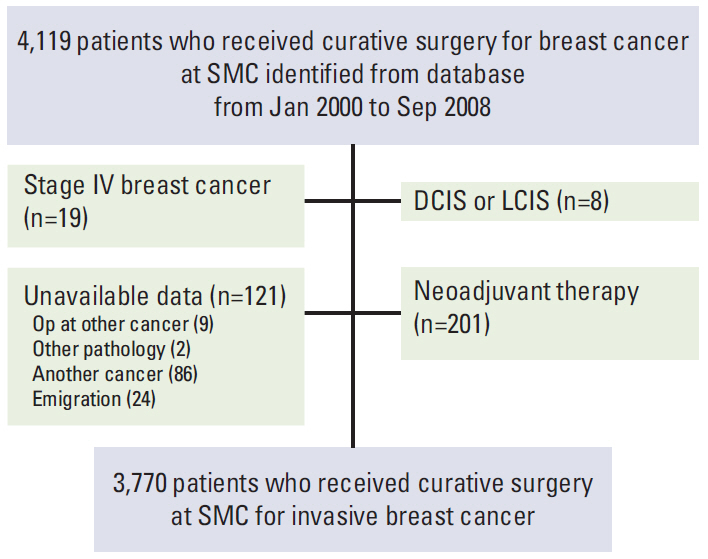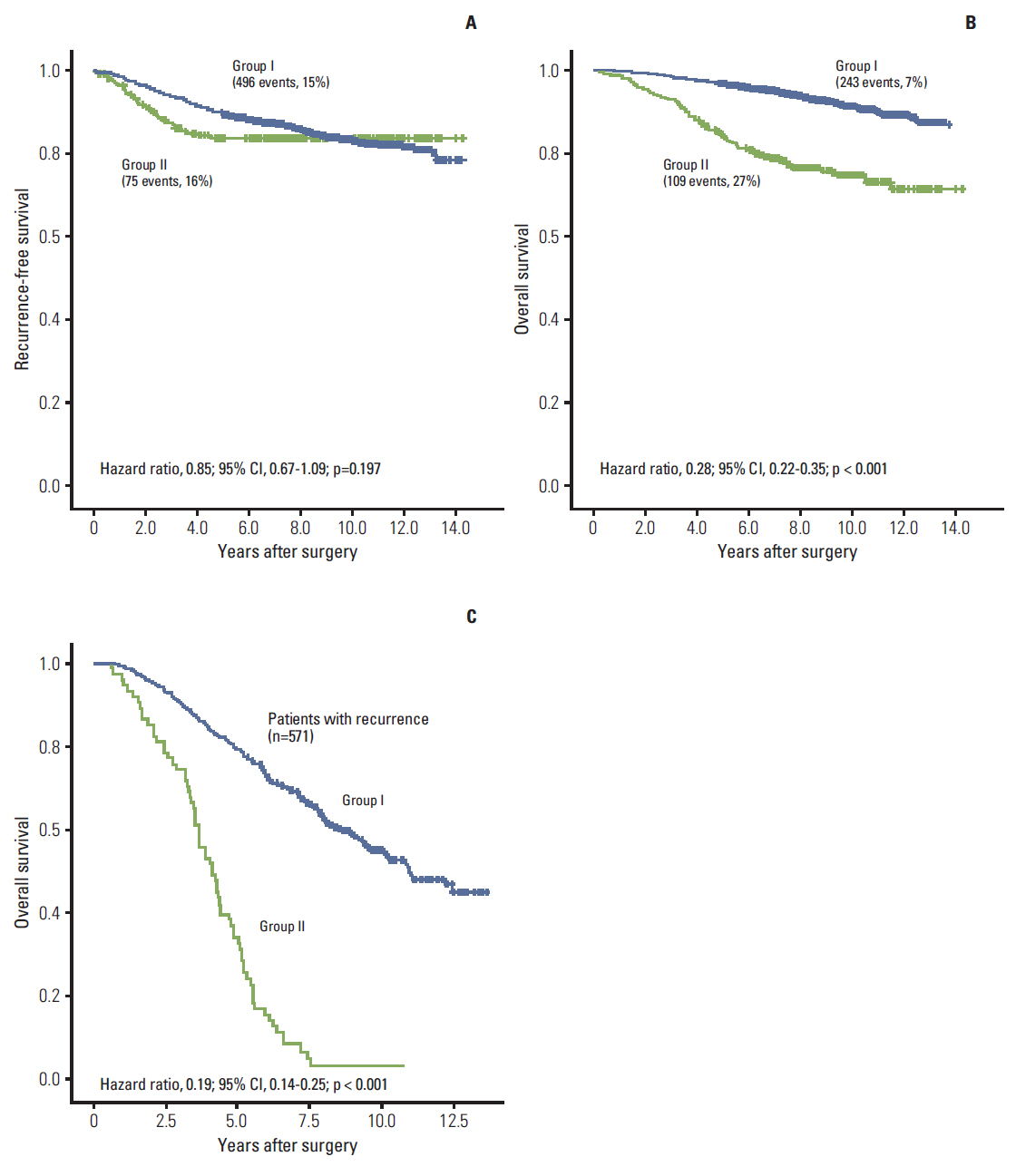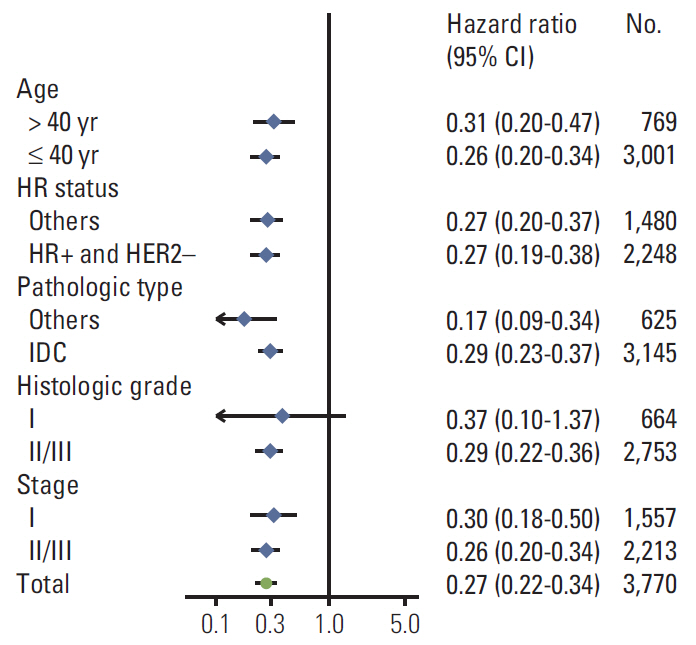Cancer Res Treat.
2015 Oct;47(4):765-773. 10.4143/crt.2014.168.
Impact on Survival of Regular Postoperative Surveillance for Patients with Early Breast Cancer
- Affiliations
-
- 1Department of Medicine, Samsung Medical Center, Sungkyunkwan University School of Medicine, Seoul, Korea. yhparkhmo@skku.edu
- 2Department of Biostatistics and Bioinformatics Center, Samsung Cancer Research Institute, Samsung Medical Center, Seoul, Korea.
- 3Department of Surgery, Samsung Medical Center, Sungkyunkwan University School of Medicine, Seoul, Korea.
- KMID: 2403395
- DOI: http://doi.org/10.4143/crt.2014.168
Abstract
- PURPOSE
The purpose of this study is to evaluate the role of regular postoperative surveillance to improve the prognosis of patients with breast cancer after curative surgery.
MATERIALS AND METHODS
We retrospectively analyzed the medical records of 4,119 patients who received curative surgery for breast cancer at Samsung Medical Center between January 2000 and September 2008. Patients were divided into two groups (group I, regular postoperative surveillance; group II, control group) according to their post-therapy follow-up status for the first 5 years after surgery.
RESULTS
Among the 3,770 patients selected for inclusion, groups I and II contained 3,300 (87%) and 470 (13%) patients, respectively. The recurrence rates at 5 years for groups I and II were 10.6% and 16.4%, respectively (hazard ratio, 0.85; 95% confidence interval [CI], 0.67 to 1.09; p=0.197). The 10-year mortality cumulative rates were 8.8% for group I and 25.4% for group II (hazard ratio, 0.28; 95% CI, 0.22 to 0.35; p < 0.001). In multivariate analysis for recurrence-free survival (RFS), age over 40 years (p < 0.001), histologic grade 1 (p < 0.001), and pathologic stage I (p < 0.001) were associated with longer RFS but not with follow-up status. Multivariate analysis for overall survival (OS) revealed that patients in group I showed significantly improved OS (hazard ratio, 0.29; 95% CI, 0.23 to 0.37; p < 0.001). Additionally, age over 40 years, histologic grade I, and pathologic stage I were independent prognostic factors for OS.
CONCLUSION
Regular follow-up for patients with breast cancer after primary surgery resulted in clinically significant improvements in patient OS.
Keyword
MeSH Terms
Figure
Reference
-
References
1. Jacobs HJ, van Dijck JA, de Kleijn EM, Kiemeney LA, Verbeek AL. Routine follow-up examinations in breast cancer patients have minimal impact on life expectancy: a simulation study. Ann Oncol. 2001; 12:1107–13.
Article2. Schapira DV, Urban N. A minimalist policy for breast cancer surveillance. JAMA. 1991; 265:380–2.
Article3. The GIVIO Investigators. Impact of follow-up testing on survival and health-related quality of life in breast cancer patients: a multicenter randomized controlled trial. JAMA. 1994; 271:1587–92.4. Joseph E, Hyacinthe M, Lyman GH, Busch C, Demps L, Reintgen DS, et al. Evaluation of an intensive strategy for follow-up and surveillance of primary breast cancer. Ann Surg Oncol. 1998; 5:522–8.
Article5. Palli D, Russo A, Saieva C, Ciatto S, Rosselli Del Turco M, Distante V, et al. Intensive vs clinical follow-up after treatment of primary breast cancer: 10-year update of a randomized trial. National Research Council Project on Breast Cancer follow-up. JAMA. 1999; 281:1586.6. Rosselli Del Turco M, Palli D, Cariddi A, Ciatto S, Pacini P, Distante V. Intensive diagnostic follow-up after treatment of primary breast cancer: a randomized trial. National Research Council Project on Breast Cancer follow-up. JAMA. 1994; 271:1593–7.
Article7. Gulliford T, Opomu M, Wilson E, Hanham I, Epstein R. Popularity of less frequent follow up for breast cancer in randomised study: initial findings from the hotline study. BMJ. 1997; 314:174–7.
Article8. Kokko R, Hakama M, Holli K. Follow-up cost of breast cancer patients with localized disease after primary treatment: a randomized trial. Breast Cancer Res Treat. 2005; 93:255–60.
Article9. Churn M, Kelly V. Outpatient follow-up after treatment for early breast cancer: updated results after 5 years. Clin Oncol (R Coll Radiol). 2001; 13:187–94.
Article10. Grosse A, Schreer I, Frischbier HJ, Maass H, Loening T, Bahnsen J. Results of breast conserving therapy for early breast cancer and the role of mammographic follow-up. Int J Radiat Oncol Biol Phys. 1997; 38:761–7.
Article11. te Boekhorst DS, Peer NG, van der Sluis RF, Wobbes T, Ruers TJ. Periodic follow-up after breast cancer and the effect on survival. Eur J Surg. 2001; 167:490–6.12. de Bock GH, Bonnema J, van der Hage J, Kievit J, van de Velde CJ. Effectiveness of routine visits and routine tests in detecting isolated locoregional recurrences after treatment for early-stage invasive breast cancer: a meta-analysis and systematic review. J Clin Oncol. 2004; 22:4010–8.
Article13. Lu WL, Jansen L, Post WJ, Bonnema J, Van de Velde JC, De Bock GH. Impact on survival of early detection of isolated breast recurrences after the primary treatment for breast cancer: a meta-analysis. Breast Cancer Res Treat. 2009; 114:403–12.
Article14. Elkhuizen PH, van de Vijver MJ, Hermans J, Zonderland HM, van de Velde CJ, Leer JW, et al. Local recurrence after breast-conserving therapy for invasive breast cancer: high incidence in young patients and association with poor survival. Int J Radiat Oncol Biol Phys. 1998; 40:859–67.15. Voogd AC, Nielsen M, Peterse JL, Blichert-Toft M, Bartelink H, Overgaard M, et al. Differences in risk factors for local and distant recurrence after breast-conserving therapy or mastectomy for stage I and II breast cancer: pooled results of two large European randomized trials. Breast Cancer Cooperative Group of the European Organization for Research and Treatment of Cancer. J Clin Oncol. 2001; 19:1688–97.16. Mellink WA, Holland R, Hendriks JH, Peeters PH, Rutgers EJ, van Daal WA. The contribution of routine follow-up mammography to an early detection of asynchronous contralateral breast cancer. Cancer. 1991; 67:1844–8.
Article17. Voogd AC, van Tienhoven G, Peterse HL, Crommelin MA, Rutgers EJ, van de Velde CJ, et al. Local recurrence after breast conservation therapy for early stage breast carcinoma: detection, treatment, and outcome in 266 patients. Dutch Study Group on Local Recurrence after Breast Conservation (BORST). Cancer. 1999; 85:437–46.18. Rojas MP, Telaro E, Russo A, Moschetti I, Coe L, Fossati R, et al. Follow-up strategies for women treated for early breast cancer. Cochrane Database Syst Rev. 2005; (1):CD001768.
Article
- Full Text Links
- Actions
-
Cited
- CITED
-
- Close
- Share
- Similar articles
-
- Utility of Regular Radiological Follow-up on Early Detection of Contralateral Malignancy and Long-term Outcomes in Metachronous Bilateral Breast Cancer Patients
- Ultrasonographic Findings of Postoperative Change after Breast Reconstruction
- Surveillance Rate and its Impact on Survival of Hepatocellular Carcinoma Patients in South Korea: A Cohort Study
- Comparison of survival outcomes between modified radical mastectomy and breast conserving surgery in early breast cancer patients
- Postoperative Surveillance of Thyroid Cancer: In View of a Radiologist




